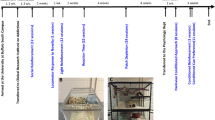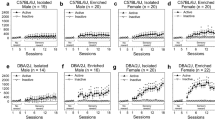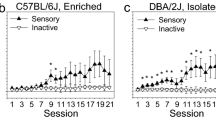Abstract
Rationale
Environmental factors influence the etiology of many psychiatric disorders. Likewise, environmental factors can alter processes central to motivation. Therefore, motivational deficits present in many disorders may be influenced by early life environmental conditions.
Objective
We examined whether housing animals in different environmental conditions influenced the ability of sensory stimuli to acquire incentive value and whether elevated monoamine activity altered responsing for these stimuli.
Methods
Isolation-housed (IH), pair-housed (PH), and environmentally enriched (EE) male C57BL/6N mice were examined in tests of responding for a conditioned reinforcer (CRf) or an unconditioned sensory reinforcer (USRf). The CRf was previously paired with saccharin delivery through Pavlovian conditioning, while the USRf was not conditioned with a reward. Following baseline tests of responding for the CRf or USRf, the effects of elevated monoamine activity were examined.
Results
At baseline, PH and EE mice responded similarly for the CRf or USRf. IH mice responded more for the CRf but exhibited slower acquisition of responding for the USRf. Administration of citalopram, a serotonin transporter blocker, or atomoxetine, a norepinephrine transporter blocker, decreased responding for the CRf and USRf in all groups. The dopamine transporter blocker GBR 12909 generally increased responding for the CRf and USRf, but further analysis revealed enhanced responding for both reinforcers only in EE mice.
Conclusions
Baseline incentive motivation is strongly influenced by the social component of housing conditions. Furthermore, environmental enrichment increased the sensitivity to elevated dopamine activity, while acute elevations in serotonin and norepinephrine inhibit incentive motivation irrespective of housing condition.





Similar content being viewed by others
References
Akdeniz C, Tost H, Meyer-Lindenberg A (2014) The neurobiology of social environmental risk for schizophrenia: an evolving research field. Soc Psychiatry Psychiatr Epidemiol 49:507–517. doi:10.1007/s00127-014-0858-4
Baarendse PJJ, Vanderschuren LJMJ (2012) Dissociable effects of monoamine reuptake inhibitors on distinct forms of impulsive behavior in rats. Psychopharmacology (Berlin) 219:313–326. doi:10.1007/s00213-011-2576-x
Bardo MT, Klebaur JE, Valone JM, Deaton C (2001) Environmental enrichment decreases intravenous self-administration of amphetamine in female and male rats. Psychopharmacology (Berlin) 155:278–284
Beckmann JS, Bardo MT (2012) Environmental enrichment reduces attribution of incentive salience to a food-associated stimulus. Behav Brain Res 226:331–334. doi:10.1016/j.bbr.2011.09.021
Beninger RJ, Ranaldi R (1992) The effects of amphetamine, apomorphine, SKF 38393, quinpirole and bromocriptine on responding for conditioned reward in rats. Behav Pharmacol 3:155–163
Bowling SL, Rowlett JK, Bardo MT (1993) The effect of environmental enrichment on amphetamine-stimulated locomotor activity, dopamine synthesis and dopamine release. Neuropharmacology 32:885–893
Brenes JC, Fornaguera J (2009) The effect of chronic fluoxetine on social isolation-induced changes on sucrose consumption, immobility behavior, and on serotonin and dopamine function in hippocampus and ventral striatum. Behav Brain Res 198:199–205. doi:10.1016/j.bbr.2008.10.036
Brenes JC, Rodríguez O, Fornaguera J (2008) Differential effect of environment enrichment and social isolation on depressive-like behavior, spontaneous activity and serotonin and norepinephrine concentration in prefrontal cortex and ventral striatum. Pharmacol Biochem Behav 89:85–93. doi:10.1016/j.pbb.2007.11.004
Browne JDC, Soko AD, Fletcher PJ (2014) Responding for conditioned reinforcement in C57BL/6 and CD-1 mice, and Sprague–Dawley rats: effects of methylphenidate and amphetamine. Psychopharmacology (Berlin) 231:4503–4516. doi:10.1007/s00213-014-3602-6
Cador M, Taylor JR, Robbins TW (1991) Potentiation of the effects of reward-related stimuli by dopaminergic-dependent mechanisms in the nucleus accumbens. Psychopharmacology (Berlin) 104:377–385
Cain ME, Green TA, Bardo MT (2006) Environmental enrichment decreases responding for visual novelty. Behav Processes 73:360–366. doi:10.1016/j.beproc.2006.08.007
Chauvet C, Lardeux V, Goldberg SR et al (2009) Environmental enrichment reduces cocaine seeking and reinstatement induced by cues and stress but not by cocaine. Neuropsychopharmacology 34:2767–2778. doi:10.1038/npp.2009.127
Darna M, Beckmann JS, Gipson CD et al (2015) Effect of environmental enrichment on dopamine and serotonin transporters and glutamate neurotransmission in medial prefrontal and orbitofrontal cortex. Brain Res 1599:115–125. doi:10.1016/j.brainres.2014.12.034
Economidou D, Dalley JW, Everitt BJ (2011) Selective norepinephrine reuptake inhibition by atomoxetine prevents cue-induced heroin and cocaine seeking. Biol Psychiatry 69:266–274. doi:10.1016/j.biopsych.2010.09.040
Felitti VJ, Anda RF, Nordenberg D et al (1998) Relationship of childhood abuse and household dysfunction to many of the leading causes of death in adults. The Adverse Childhood Experiences (ACE) Study. Am J Prev Med 14:245–258
Fletcher PJ (1995) Effects of d-fenfluramine and metergoline on responding for conditioned reward and the response potentiating effect of nucleus accumbens d-amphetamine. Psychopharmacology (Berlin) 118:155–163
Fletcher PJ, Korth KM, Chambers JW (1999) Selective destruction of brain serotonin neurons by 5,7-dihydroxytryptamine increases responding for a conditioned reward. Psychopharmacology (Berlin) 147:291–299
Fone KCF, Porkess MV (2008) Behavioural and neurochemical effects of post-weaning social isolation in rodents—relevance to developmental neuropsychiatric disorders. Neurosci Biobehav Rev 32:1087–1102. doi:10.1016/j.neubiorev.2008.03.003
Fone KC, Shalders K, Fox ZD et al (1996) Increased 5-HT2C receptor responsiveness occurs on rearing rats in social isolation. Psychopharmacology (Berlin) 123:346–352
Fulford AJ, Marsden CA (1997) Social isolation in the rat enhances alpha 2-autoreceptor function in the hippocampus in vivo. Neuroscience 77:57–64
Galani R, Berthel M-C, Lazarus C et al (2007) The behavioral effects of enriched housing are not altered by serotonin depletion but enrichment alters hippocampal neurochemistry. Neurobiol Learn Mem 88:1–10. doi:10.1016/j.nlm.2007.03.009
Gentsch C, Lichtsteiner M, Kraeuchi K, Feer H (1982) Different reaction patterns in individually and socially reared rats during exposures to novel environments. Behav Brain Res 4:45–54
Grimm JW, Osincup D, Wells B et al (2008) Environmental enrichment attenuates cue-induced reinstatement of sucrose seeking in rats. Behav Pharmacol 19:777–785. doi:10.1097/FBP.0b013e32831c3b18
Hall FS, Humby T, Wilkinson LS, Robbins TW (1997) The effects of isolation-rearing on sucrose consumption in rats. Physiol Behav 62:291–297
Hall FS, Wilkinson LS, Humby T et al (1998) Isolation rearing in rats: pre- and postsynaptic changes in striatal dopaminergic systems. Pharmacol Biochem Behav 59:859–872
Han DD, Gu HH (2006) Comparison of the monoamine transporters from human and mouse in their sensitivities to psychostimulant drugs. BMC Pharmacol 6:6. doi:10.1186/1471-2210-6-6
Heidbreder CA, Weiss IC, Domeney AM et al (2000) Behavioral, neurochemical and endocrinological characterization of the early social isolation syndrome. Neuroscience 100:749–768
Hoffmann LC, Schütte SRM, Koch M, Schwabe K (2009) Effect of “enriched environment” during development on adult rat behavior and response to the dopamine receptor agonist apomorphine. Neuroscience 158:1589–1598. doi:10.1016/j.neuroscience.2008.11.035
Howes SR, Dalley JW, Morrison CH et al (2000) Leftward shift in the acquisition of cocaine self-administration in isolation-reared rats: relationship to extracellular levels of dopamine, serotonin and glutamate in the nucleus accumbens and amygdala-striatal FOS expression. Psychopharmacology (Berlin) 151:55–63
Jones GH, Marsden CA, Robbins TW (1990) Increased sensitivity to amphetamine and reward-related stimuli following social isolation in rats: possible disruption of dopamine-dependent mechanisms of the nucleus accumbens. Psychopharmacology (Berlin) 102:364–372
Katz RJ, Carroll BJ (1977) Intracranial reward after Lilly 110140 (fluoxetine HCl): evidence for an inhibitory role for serotonin. Psychopharmacology (Berlin) 51:189–193
Keller KL, Vollrath-Smith FR, Jafari M, Ikemoto S (2014) Synergistic interaction between caloric restriction and amphetamine in food-unrelated approach behavior of rats. Psychopharmacology (Berlin) 231:825–840. doi:10.1007/s00213-013-3300-9
Kelley AE, Delfs JM (1991) Dopamine and conditioned reinforcement. I. Differential effects of amphetamine microinjections into striatal subregions. Psychopharmacology 103:187–196
Kornblith CL, Hoebel BG (1976) A dose–response study of anorectic drug effects on food intake, self-stimulation, and stimulation-escape. Pharmacol Biochem Behav 5:215–218
Laviola G, Hannan AJ, Macrì S et al (2008) Effects of enriched environment on animal models of neurodegenerative diseases and psychiatric disorders. Neurobiol Dis 31:159–168. doi:10.1016/j.nbd.2008.05.001
Lee K, Kornetsky C (1998) Acute and chronic fluoxetine treatment decreases the sensitivity of rats to rewarding brain stimulation. Pharmacol Biochem Behav 60:539–544
Mead AN, Stephens DN (2003) Involvement of AMPA receptor GluR2 subunits in stimulus-reward learning: evidence from glutamate receptor gria2 knock-out mice. J Neurosci 23:9500–9507
Navarra R, Graf R, Huang Y et al (2008) Effects of atomoxetine and methylphenidate on attention and impulsivity in the 5-choice serial reaction time test. Prog Neuropsychopharmacol Biol Psychiatry 32:34–41. doi:10.1016/j.pnpbp.2007.06.017
Nithianantharajah J, Hannan AJ (2006) Enriched environments, experience-dependent plasticity and disorders of the nervous system. Nat Rev Neurosci 7:697–709. doi:10.1038/nrn1970
Olsen CM, Winder DG (2009) Operant sensation seeking engages similar neural substrates to operant drug seeking in C57 mice. Neuropsychopharmacology 34:1685–1694. doi:10.1038/npp.2008.226
Olsen CM, Winder DG (2012) Stimulus dynamics increase the self-administration of compound visual and auditory stimuli. Neurosci Lett 511:8–11. doi:10.1016/j.neulet.2011.12.068
Richardson NR, Roberts DC (1991) Fluoxetine pretreatment reduces breaking points on a progressive ratio schedule reinforced by intravenous cocaine self-administration in the rat. Life Sci 49:833–840
Robbins TW (1978) The acquisition of responding with conditioned reinforcement: effects of pipradrol, methylphenidate, d-amphetamine, and nomifensine. Psychopharmacology (Berlin) 58:79–87
Robbins TW, Watson BA, Gaskin M, Ennis C (1983) Contrasting interactions of pipradrol, d-amphetamine, cocaine, cocaine analogues, apomorphine and other drugs with conditioned reinforcement. Psychopharmacology (Berlin) 80:113–119
Robinson TE, Berridge KC (1993) The neural basis of drug craving: an incentive-sensitization theory of addiction. Brain Res Rev 18:247–291
Sanders AC, Hussain AJ, Hen R, Zhuang X (2007) Chronic blockade or constitutive deletion of the serotonin transporter reduces operant responding for food reward. Neuropsychopharmacology 32:2321–2329. doi:10.1038/sj.npp.1301368
Shin R, Cao J, Webb SM, Ikemoto S (2010) Amphetamine administration into the ventral striatum facilitates behavioral interaction with unconditioned visual signals in rats. PLoS One 5:e8741. doi:10.1371/journal.pone.0008741
Simpson J, Kelly JP (2011) The impact of environmental enrichment in laboratory rats—behavioural and neurochemical aspects. Behav Brain Res 222:246–264. doi:10.1016/j.bbr.2011.04.002
Smith JK, Neill JC, Costall B (1997) Post-weaning housing conditions influence the behavioural effects of cocaine and d-amphetamine. Psychopharmacology (Berlin) 131:23–33
Solinas M, Chauvet C, Thiriet N et al (2008) Reversal of cocaine addiction by environmental enrichment. Proc Natl Acad Sci U S A 105:17145–17150. doi:10.1073/pnas.0806889105
Solinas M, Thiriet N, Chauvet C, Jaber M (2010) Prevention and treatment of drug addiction by environmental enrichment. Prog Neurobiol 92:572–592. doi:10.1016/j.pneurobio.2010.08.002
Stewart J (1960) Reinforcing effects of light as a function of intensity and reinforcement schedule. J Comp Physiol Psychol 53:187–193
Sutton MA, Beninger RJ (1999) Psychopharmacology of conditioned reward: evidence for a rewarding signal at D1-like dopamine receptors. Psychopharmacology 144:95–110
Taylor JR, Robbins TW (1984) Enhanced behavioural control by conditioned reinforcers following microinjections of d-amphetamine into the nucleus accumbens. Psychopharmacology 84:405–412
Welte JW, Barnes GM, Wieczorek WF et al (2004) Risk factors for pathological gambling. Addict Behav 29:323–335
Young JW, Goey AKL, Minassian A, et al (2010) GBR 12909 administration as a mouse model of bipolar disorder mania: mimicking quantitative assessment of manic behavior. Psychopharmacology (Berlin) 208:443–54. doi:10.1007/s00213-009-1744-8
Acknowledgments
This research was supported by a Doctoral award from the Natural Sciences and Engineering Research Council to CJB and a Canadian Institutes of Health Research operating grant to PJF. FDZ receives salary support through a Canadian Institutes of Health Research Postdoctoral fellowship.
Author information
Authors and Affiliations
Corresponding author
Rights and permissions
About this article
Cite this article
Browne, C.J., Fletcher, P.J. & Zeeb, F.D. Responding for a conditioned reinforcer or unconditioned sensory reinforcer in mice: interactions with environmental enrichment, social isolation, and monoamine reuptake inhibitors. Psychopharmacology 233, 983–993 (2016). https://doi.org/10.1007/s00213-015-4178-5
Received:
Accepted:
Published:
Issue Date:
DOI: https://doi.org/10.1007/s00213-015-4178-5




